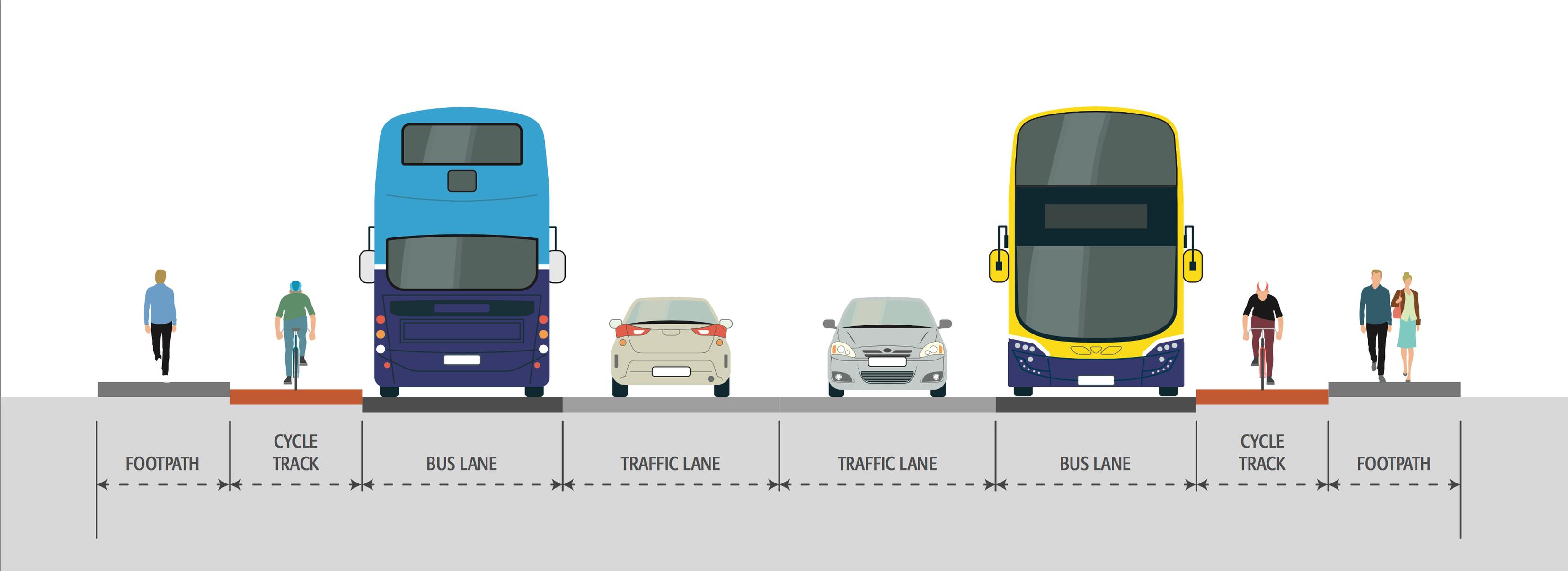

Proposals to re-design street layouts across Dublin to provide new bus and cycle lanes will require the removal of on-street parking bays and sections of front gardens.
The Irish National Transport Authority (NTA) has published a discussion document - Core Bus Corridors Project - which sets out draft proposals to improve bus journey times and cycling priority along an increasing number of congested corridors in the Dublin region.
The project is part of the NTA’s Government funded €2bn (£1.76bn) BusConnects Dublin programme to transform the city’s bus system by 2027.
If implemented, the proposals would provide:
The NTA estimate that the new routes would result in journey timesaving of up to 40%-50% across the 16 radial bus corridors.
An NTA spokesman told Parking Review magazine: “Because there is so little unused space along these busy roads, it will often not be possible to accommodate the bus lanes and cycle lanes in the width available. In order to achieve the required space it will be necessary, in places, to acquire parts of front gardens and land in front of commercial properties to allow the bus and cycle lanes to be provided.”
This would require rebuilding new garden walls a short distance back from the existing road boundary, the spokesman said.
“Because the roads we are widening travel through residential and business areas there will be a need to reduce the amount of on-street parking to accommodate the new layout. As with the need to remove some parts of front gardens and footpaths, there will also be a need to remove trees along some of the corridors. The public consultation stage later this year will have details and locations of the trees and lands impacted, once the initial designs are developed,” the spokesman told Parking Review.
“Widening roads, and building bus and cycle lanes, requires a certain amount of construction work. There will be excavation of the existing roads, plus parts of gardens and footpaths where needed. There will be resurfacing, kerbing, replanting and landscaping. During the construction stages, the construction sites will be localised and managed on a road-by-road basis. As with any work site and road works, there will be a certain level of noise, dust and temporary traffic diversions.”
The discussion document states that despite the importance of the bus system, the main corridors in the city only have bus lanes for about one-third of their length. This means that for most of the journey, buses are competing for space with other traffic and are affected by general traffic congestion.
With the population of the Dublin region projected to increase to 1.5m by 2040, a jump of 25% from today’s 1.2m, the trend of increasing congestion will continue unless significant and radical action is taken, said the report.
This “radical action” will include widening roads, converting current traffic lanes to bus lanes and restricting on-street parking, said NTA’s spokesman.
“These are tough choices, which cannot, and will not, be made lightly. Not all the impacts will be felt equally and some locations will require more changes than others. Over the years modifications that were easier to implement - the ones that caused little or no disruption - have been made. This means that there are no longer any simple changes, which we can make that would generate meaningful benefits”.
He added: “A better cycling network is good for all transport users. It avoids cyclists sharing bus lanes with buses and will remove many of the conflicts between buses and cyclists. This initiative is the foundation of the overall cycle network that has been planned for the Greater Dublin Area.
“On each of the 16 radial core bus corridors our objective is to provide high quality cycling facilities, segregated from the bus lanes and general traffic lanes as far as is feasible. We calculate that over 200km of cycle tracks/lanes will be either built or current lanes improved upon.
“So, we now need to make significant changes if we are to allow Dublin to grow and flourish into the future. Quite simply, if we genuinely want to put in place a much better public transport system, our bus system, which carries over two-thirds of Dublin’s transport passengers, has to be upgraded to meet the future demands that are going to be placed upon it.”
TransportXtra is part of Landor LINKS
© 2026 TransportXtra | Landor LINKS Ltd | All Rights Reserved
Subscriptions, Magazines & Online Access Enquires
[Frequently Asked Questions]
Email: subs.ltt@landor.co.uk | Tel: +44 (0) 20 7091 7959
Shop & Accounts Enquires
Email: accounts@landor.co.uk | Tel: +44 (0) 20 7091 7855
Advertising Sales & Recruitment Enquires
Email: daniel@landor.co.uk | Tel: +44 (0) 20 7091 7861
Events & Conference Enquires
Email: conferences@landor.co.uk | Tel: +44 (0) 20 7091 7865
Press Releases & Editorial Enquires
Email: info@transportxtra.com | Tel: +44 (0) 20 7091 7875
Privacy Policy | Terms and Conditions | Advertise
Web design london by Brainiac Media 2020